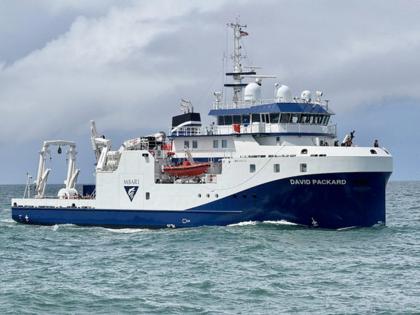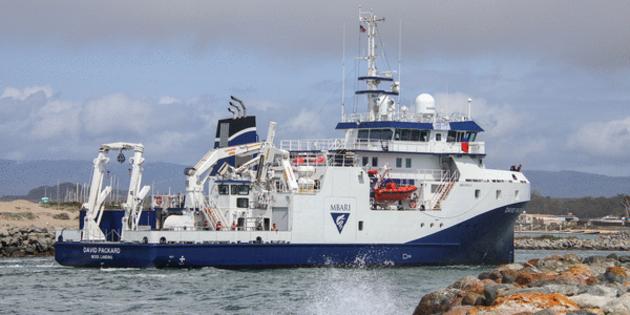Underwater robots, great white sharks and glowing jellyfish: New $50 million high-tech ship arrives to unlock ocean mysteries
Published in Science & Technology News
During his lifetime, David Packard was a Silicon Valley pioneer, starting one of the nation’s leading tech companies, Hewlett Packard, in his Palo Alto, California, garage with his friend Bill Hewlett and $538, and then using the fortune he earned to explore and preserve the world’s oceans.
Although Packard died in 1996, the latest of his philanthropic efforts is ready to set sail off the Northern California coast.
Scientists at the Monterey Bay Aquarium Research Institute have unveiled a new $50 million state-of-the-art flagship vessel, named the David Packard, at the marine science center he funded in Moss Landing, California. The 164-foot long ship, constructed in Spain and funded by the David and Lucile Packard Foundation, arrived two weeks ago after a two-month journey. It will hold 12 crew members and 18 scientists, focusing on deep sea research off California’s coastline, Monterey Bay and other parts of the world.
“There’s a lot of new technology, a lot of cool things, on this ship,” said Kaya Johnson, the institute’s director of marine operations.
On Tuesday the ship sat in dry dock in Alameda. Crews inspected its hull and equipment. After a range of high-tech gear has been installed and fine-tuned — including multi-beam sonar to map the ocean floor, laboratories that chill water to re-create conditions found in extreme depths, and acoustic sensors that talk to underwater robots gliding through the ocean with high-definition video cameras — the ship will take its maiden voyage in late June, Johnson said.
That will be a four or five-day cruise to collect jellyfish, fish and other specimens for the Monterey Bay Aquarium’s deep-sea exhibition. Afterward, the ship will study everything from climate change to fisheries to discovering new species.
“There’s a lot of buzz,” Johnson said. “People here are excited and already dreaming about different opportunities. I have a tough time getting from one side of the building to the other because so many people have questions about it.”
MBARI, as the Moss Landing-based organization is known, is a separate non-profit organization from the Monterey Bay Aquarium, located 20 miles to the south in Monterey.
Packard built the aquarium in 1984 with a $55 million gift. It receives about 2 million visitors a year who marvel at its sea otters, jellyfish, sea birds and sharks. Although he was proud of the educational opportunities the aquarium affords to thousands of children and the public every year, Packard, an engineer, was most fascinated by deep sea research.
“The oceans are a more important frontier,” Packard said in a 1989 speech, “for research that will bring more tangible benefits to the world than space, or high energy physics, or other areas that have received a high level of public interest and therefore political support. It is about time someone gave ocean science more attention.”
Packard believed America spent too much money on space exploration and not enough on exploring Earth’s oceans. Not only do the oceans cover 71% of the world’s surface, they provide food and impact the weather. Their plankton, kelp and other plants create 50% of the world’s oxygen.
With a $13 million donation, he founded MBARI in 1987 in an effort to create a new marine engineering hub comparable with the Woods Hole Oceanographic Institution in Massachusetts or the Scripps Institution of Oceanography in San Diego.
After Packard died in 1996 at age 83, he left the bulk of his estate to the David and Lucile Packard Foundation. The foundation has provided $1.2 billion to MBARI over the past 37 years, making the Packard family the world’s leading private benefactors of ocean research.
Packard himself helped design MBARI’s previous flagship, the 117-foot Western Flyer, which MBARI donated to the Florida Institute of Oceanography in St. Petersburg, Fla. in 2023.
The new ship will hold more researchers and stay at sea for 30 days instead of 10. It also will become the main launch point for the Doc Ricketts, MBARI’s remotely operated vehicle that can dive more than 2 miles underwater to the ocean floor.
And it will be able to launch multiple “AUVs” — torpedo-like robot probes that can take underwater video, map the sea floor and collect water samples on days-long journeys and transmit the results back to shore.
In recent decades, MBARI’s engineers and scientists designed unmanned submersibles, once mostly used in oil exploration. They fitted them with high-end cameras and other gear, probing the dark world more than 3,000 feet below the ocean’s surface, and often beaming the video to crowds at the aquarium of white sharks, squid, and deep sea fish that look like space aliens.
MBARI scientists have discovered more than 250 new species of marine creatures never seen before. Among them: a type of giant red jellyfish three feet wide, sponges shaped like umbrellas, and pulsating rope-like creatures with tentacles that glow in the dark called siphonophores that can grow to be 100 feet long.
MBARI scientists also discovered the wreckage of the USS Macon, a 785-foot dirigible that crashed into the ocean off Big Sur in 1935. They explored Davidson Seamount, a dormant undersea volcano 80 miles southwest of Monterey with huge forests of undersea coral. Afterward, federal officials expanded the Monterey Bay National Marine Sanctuary to better protect them.
“We’re out to discover our oceans, create new technology and share it with the rest of the world,” Johnson said. “What happens in our ocean affects the whole planet.”
©#YR@ MediaNews Group, Inc. Visit at mercurynews.com. Distributed by Tribune Content Agency, LLC.










Comments